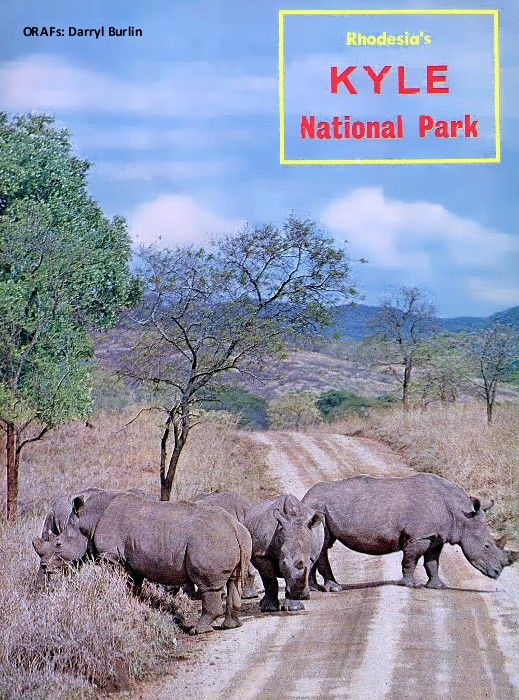
KYLE National Park, situated on the south-eastern edge of the Highveld, is one of the loveliest, of Rhodesia's many national parks. Centred on Lake Kyle, the second largest lake in the country (which was created as part of the vast irrigation complex for the Lowveld), the park offers the visitor beautiful scenery, boating and fishing, and some of the most concentrated and interesting game viewing in Rhodesia.

The roadway across the 203-fool-high dam wall leads to the scenic Murray MeDougall Drive, On the hill overlooking the wall is a small tearoom.
The sealing of the Mtilikwe River by the 200-foot-high, 1,000 foot-long Kyle dam has caused the river to flood back up the valleys of its tributaries until the lake now spreads over 35 square miles, with one of the most varied shorelines of any of Rhodesia's inland waters.
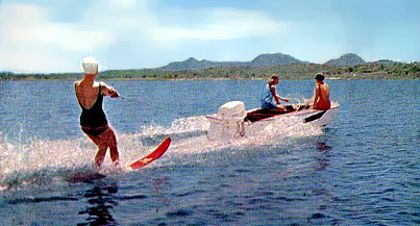
Skiing across the blue waters, with the Nyuni Mountains in the background.
Boating on these wide expanses of water is very popular, and from the clubs situated on the southern shore, quite close to the dam wall, the bright sails of yachts and the creaming wakes of power-boats and water-skiers add colour to the scene, Many visitors hire boats and explore the hundred-and-one picturesque bays and inlets along the 160-mile-long shoreline, or the small islands of tumbled rocks, on many of which cormorants and herons have established nesting colonies. Others take guided boat tours.
As the lake has grown, thousands of black bass fingerlings have been introduced, and these have grown so well that an international bass-fishing contest is held here each year. The largest bass caught in the lake weighed over 7 lb., but catches of up to 4 lb. are quite common. The Rhodesian bream (or more correctly Tilapia mcianopleura) is also present in large numbers. Moreover, fishing can be enjoyed the whole year round.

Fishing for bass can be enjoyed all year round at Kyle. The record bass caught weighed 7 lb., but catches of 4 lb. arc quite common. Licences are available from the Kyle and Zimbabwe National Parks' offices
The park is best known, however. for its 20,000-acre game reserve situated on the lake's northern shore. There are over 30 rare White, or square-lipped, rhino in this reserve, and they can often be seen in groups of six or seven. The good conditions under which the animals live have favoured a high breeding rate, and the young of most species in the reserve can be seen, the young rhino calves being a firm favourite among visitors.
Another attractive feature of this reserve is the great variety of antelope to be seen—more species than in any other single national park including the very rare oribi. Lichtenstein's hartebeeste, blesbok and nyala. Along the 40 miles of gravel roads that traverse the reserve motorists have a wonderful opportunity to see an abundance of wild life at close quarters. The reserve is open the whole year round, although in extremely wet weather some of the roads may be closed.

Kyle Game Reserve is the home of some of Rhodesia's rarer types of antelope, Nyala (Above), Tssessebe (Below), oribi. blesbok and Liehtenslein's hartebeeste. seldom seen in other national parks, can be approached quite closely by visitors iri their cars.

Below. Within the game revive, these lodges provide complete facilities for the holidaymaker. including a servant. Visitors need only bring their food..
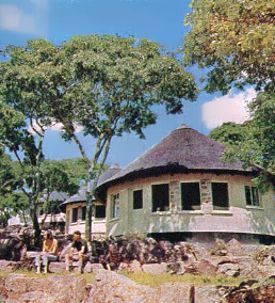
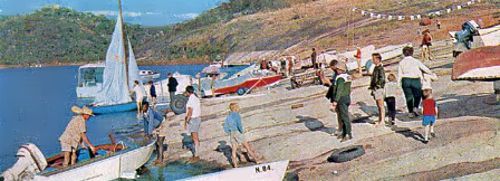
Above. On the southern side of the lake, at the thriving Kyle Boat Club, regular regattas and power-boat races are held. Visitors are always welcome, but all craft must he registered withi the Warden.
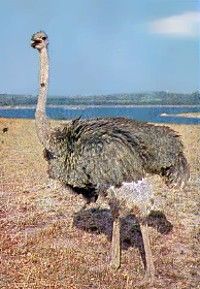
Above. Around the lake and on the numerous islands is a prolific bird lite, white in the reserve the world's largest bird, the ostrich, can be seen.
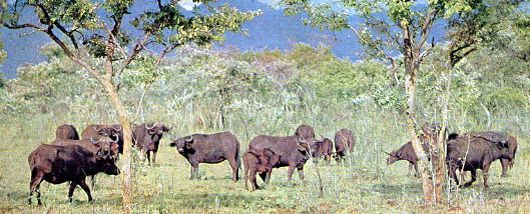
Above. As well as the rarer types of antelope and the While rhino, the reserve has good populations of Buffalo, Eland, Sable, Zebra, Kudu, Waterbuck, Impala, Wildebeeste and Reedbuck.
Below. There are attractive caravan parks, both on the southern shore of the lake and within the game reserve itself.

Below. Evening light, adds to the beauty of this lake land national park.

Within the game reserve itself is a rest camp which can only be described as "luxury in the bundu".
Built on a hill overlooking the lake, six two-bed and three four- bed lodges rise in terraces in the shade of Msasa trees. These are fully furnished, including a gas cooker, refrigerator, crockery, cutlery, pots and pans, bed linen, blankets and towels. A servant is provided. On a nearby hill is a caravan and camping site, which also enjoys a beautiful view of the lake.
Wherever one is at Kyle, whether on the lake or in the reserve, there is always a background of lovely scenery. To the west, bordering the reserve, rise the soft outlines of the Beza Range, while to the east the more dramatic peaks of the Nyuni Mountains rise, thickly wooded to their summits, like colossal draperies.
A favourite scenic road is the Murray McDougall Drive, named after one of the pioneers of the Lowveld development. It runs from the dam walk skirting the western shores of the lake and passing under the shadow of the Nyuni Mountains untill it joins the main Fort Victoria-Birchenough Bridge road 17 miles east of Fort Victoria. For visitors staying in the rest camp at the reserve the journey can be made in the opposite direction, with a break at the Zimbabwe Ruins for tea or lunch.
HOW TO GET THERE
The nearest town to Kyle National Park is Fort Victoria, which is 178 miles south of Salisbury and 179 mites north-east of Bulawayo. Access to the northern shore of the lake, where the game reserve and rest camp is situated, is gained from a turn-off eight miles east of Fort Victoria on the road to Birchenough Bridge. From this turn-off a well-maintained gravel road leads for 12 miles to the rest camp, passing through part of the game reserve. The southern shore, where there is chalet and camping accommodation and caravan parks, and where the boat clubs and dam wall are to be found, is 24 miles south of Fort Victoria, on the road that passes through the Zimbabwe National Park, There are hotels at Fort Victoria, Zimbabwe and just off the Murray McDougall Drive in the Nyuni Mountains.
Reprinted from "Rhodesia Calls" by Unitas Press, Rhodesia, and issued by the Rhodesia National Tourist Board.
End
Extracted and recompiled by Eddy Norris from material made available by Darryl Burlin. Thanks Darryl.
Comments are always welcome, send them to Eddy Norris at orafs11@gmail.com
To view the Blog Home Page - Please Click Here.
(Please visit our previous posts and archives)
No comments:
Post a Comment